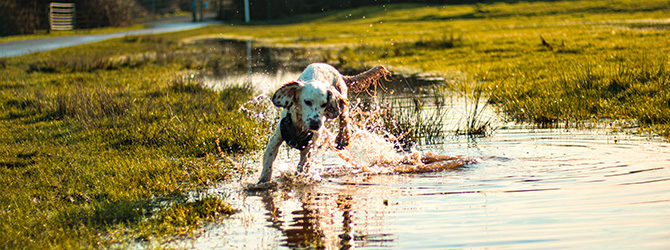Blue-green algae poisoning in dogs
Blue-green algae is not actually algae.
The term refers to large clusters of bacteria — known as cyanobacteria — that are so small, they can’t be seen by the naked eye unless they group together. Clusters of these bacteria (also called ‘blooms’) look like algae in the water, hence the name.
These bacteria thrive in warm, nutrient-rich water, like lakes and ponds, and are especially common during warm spells or periods with no rain. The danger to dogs lies in the toxins produced by these bacteria.
In this article, we'll guide you through everything you need to know about blue-green algae poisoning in dogs. We'll cover what it is, why it's dangerous, blue-green algae symptoms, and most importantly, how to prevent blue-green algae poisoning.
You should contact your vet immediately if you think your dog has come into contact with blue-green algae.
Brief summary
- Blue-green algae are groups of tiny bacteria that typically live in still, nutrient-rich water
- They produce toxins that are harmful to dogs, with one study showing that around half of dogs exposed to these toxins die
- Most poisonings occur from dogs drinking or swimming in freshwater lakes and ponds
- Symptoms include vomiting, diarrhoea, muscle tremors and seizures and these can appear within under an hour after exposure
- To prevent poisoning, avoid risky areas, check for algae warnings, and rinse dogs after swimming
Why is blue-green algae dangerous to dogs?
When dogs drink or swim in water contaminated by blue-green algae, they can easily ingest the toxins produced by the cyanobacteria. The cyanobacteria produce four main types of toxins.
- Hepatotoxins - damage the liver by affecting the cell proteins. This can lead to liver failure and necrosis (death of the cells)
- Neurotoxins - attack the brain and nervous system. They can be rapidly fatal.
- Nephrotoxins - induce kidney failure by destroying the cells. Your dog may show signs of excessive thirst and increased urination
- Dermal toxins - skin irritation, hives, rashes or burns are all results of dermal toxins
These toxins can all lead to pain, discomfort and serious illness. In one study of 368 cases of cyanotoxin poisonings in dogs the mortality rate was around 50%.
That's why it's so important for dog owners to be aware of the risks of blue-green algae and take steps to prevent our dogs from coming into contact with blue-green algae.
What does blue-green algae look like?
Blue-green algae can look different depending on where it is and what type it is.
- Colour: It's often blue-green, but it can also look greenish-brown or even red
- Shape: It can form thick layers on the water's surface that look like foam, paint or scum. Some people say it looks like pea soup or spilled paint
- Smell: Some types of blue-green algae can smell pungent
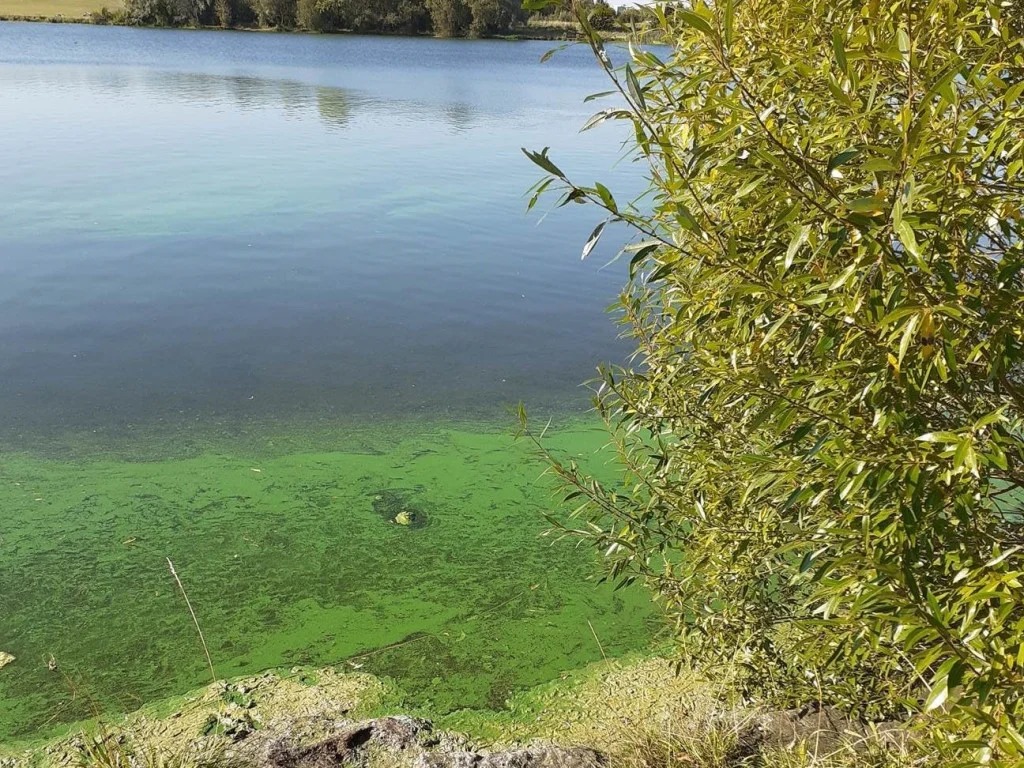
Remember, you can't always see blue-green algae with your eyes alone. It is only easy to spot when there’s a large quantity, as the actual bacteria are tiny. It can also look like other harmless water plants. So, if you see anything unusual on the water's surface, keep your dog on dry land to be safe.
What causes blue-green algae?
Blue-green algae isn't the result of a single cause, but rather a combination of several. The most common include:
Nutrient overload
This happens when too many nutrients are in the water, such as nitrogen and phosphorus. A surfeit of nutrients, such as nitrogen and phosphorus, in the water can lead to blue-green algae blooms.
Warm temperatures and calm conditions
Blue-green algae thrive in warm, calm waters. They grow best in water temperatures above 24°C (75°F).
Changes in water chemistry
Changes in water chemistry, such as pH or salinity, can influence the growth of cyanobacteria.
Climate change
Climate change is also believed to play a role in the increasing occurrence of harmful algal blooms. Rising temperatures can extend the growing season of cyanobacteria and increase the likelihood of blooms.
Has any research been done into blue-green algae poisoning in dogs?
One study published in 2013 found the majority of blue-green algae poisonings in dogs came from freshwater lakes and ponds. It also said reported cases have increased over time, and that the most common clinical signs were vomiting, diarrhoea and lethargy. Around half of the dogs analysed in this study died.
Another US-based academic paper from 2013 concluded that oral cholestyramine, a bile acid sequestrant, may be able to help treat blue-green algae poisoning in dogs. It revealed promising results from the treatment, but said more research was needed as this study involved only one dog. Prevention, such as avoiding potentially contaminated water, was cited as the best strategy for dog owners.
Is there any blue-green algae near me?
Symptoms of blue-green algae poisoning in dogs
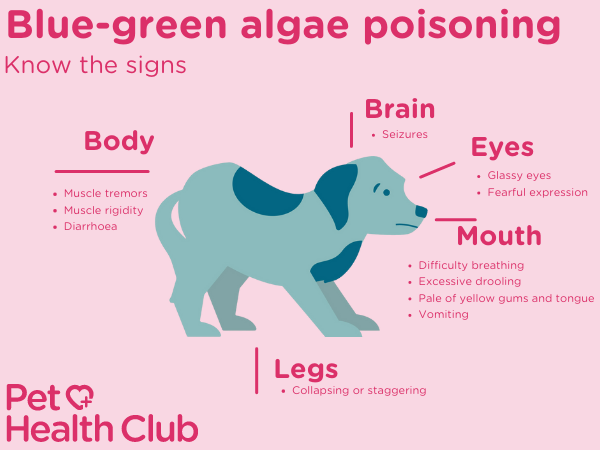
If your dog has been exposed to blue-green algae, they might start showing signs within minutes to hours. These symptoms can include:
- Vomiting
- Diarrhoea
- Weakness or collapse
- Pale or yellow gums
- Drooling
- Muscle tremors
- Difficulty breathing
- Muscle rigidity
- Seizures
Contact your vet immediately if your dog displays any of these symptoms, or if you think your dog has been in contact with blue-green algae. The sooner your dog gets treatment, the better their chances of recovery. In severe cases, blue-green algae poisoning can lead to death.
Bear in mind that some of these symptoms are also common to other conditions, such as heatstroke, but your vet should be able to diagnose the underlying cause.
Treatment of blue-green algae poisoning in dogs
There's no specific cure for the toxins produced by blue-green algae, but quick and thorough vet care can greatly improve a dog's chances of getting better.
The main part of treatment is supportive care. This means helping your dog deal with the symptoms and avoid further health problems. Here's what that involves:
- Emetics - if the ingestion is ery recent, the vet may make your dog sick, or pump the stomach to try and get the toxins out of the body
- Intravenous fluids, given through a drip: fluids keep the dog hydrated, support the kidneys and liver (which can be affected by the toxins), and help flush the toxins from the dog's body
- Oxygen: If the dog is struggling to breathe or has lung damage, they might need oxygen supplemented via a mask or nasal prongs
- Anti-seizure medication: The toxins from blue-green algae can cause seizures. These medicines help control seizures and prevent more damage to the brain
- Electrolytes and glucose: imbalances in these vital molecules can cause acute deterioration in health, so need careful monitoring
- Blood products: If the dog’s liver and kidneys are badly affected, they can have blood clotting problems which require treatment or transfusion
- Activated charcoal: This might be given if the dog is seen soon after ingesting the toxins. It can bind the toxins in the dog's stomach and intestines and stop more from getting into the dog’s system
With quick action and thorough care, some dogs can get better from this serious type of poisoning.
Read more: Dog vaccinations: keeping your puppy happy and healthy.
What is the prognosis for blue-green algae poisoning in dogs?
If your dog has ingested the blue-green algae, the prognosis is poor. Many dogs will die from the toxins despite aggressive veterinary care. Depending on the type of toxin that is attacking your dog, they may even die before reaching the vet.
If your dog does survive the initial symptoms, then they should have a good chance of recovery. However, it may take weeks or months to regain their health due to damage to the kidneys or liver.
Read more: Getting a new puppy: the ultimate guide.
What dogs are at particular risk?
Water-loving breeds of dogs, including retrievers, are particularly susceptible to harm. Gun dogs, for example, are especially vulnerable, as are dogs that live in areas with large amounts of water nearby and those who prefer to drink from natural sources.
Preventing blue-green algae poisoning
Prevention is key for keeping your dog safe.
Avoid risky areas
Keep your dog on a lead near murky or matted water. Blue-green algae can look like blue-green or red brown blooms, mats, foam, or scum on the water.
Check signage and online
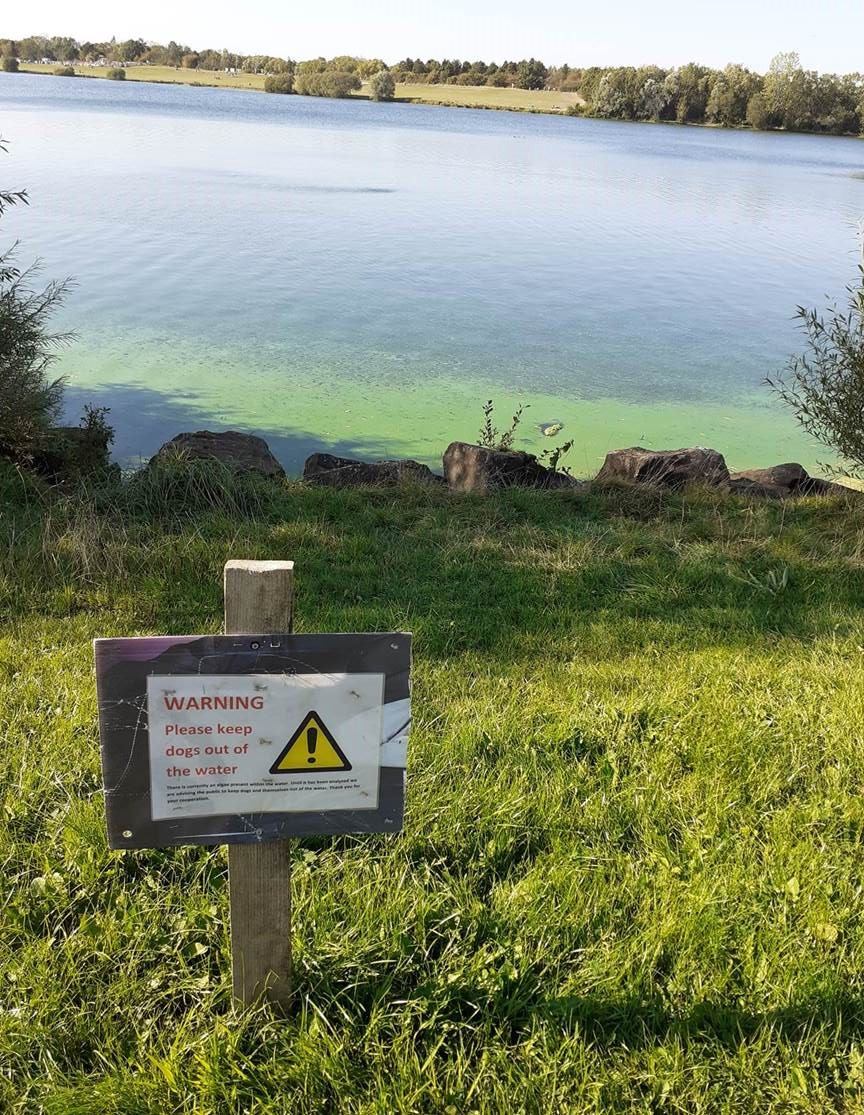
Before visiting any lake or pond with your dog, check for any warnings about blue-green algae. The UK Centre for Ecology & Hydrology has an interactive map which allows you to see where blue-green algae has formed. Many lakes and ponds have warning signs up during the algae season - it’s important to check for local information.
Clean up standing water
Remove stagnant water around your home, such as in plant containers, garden ponds or birdbaths, to prevent the growth of blue-green algae.
Bring fresh drinking water
Offering your dog fresh drinking water is preferable to letting them drink from ground or standing water which have been contaminated by cyanobacteria.
Rinse your dog after swimming
If your dog goes swimming, rinse them off with clean water immediately afterwards. This can help remove any algae that may have stuck to their fur.
Remember, the key to keeping your dog safe is knowledge and prevention. By being aware of the dangers of blue-green algae and taking the necessary steps to prevent exposure, you can help keep your dog happy and healthy.
Frequently asked questions
What other water-related dangers are there for dogs?
Blue-green algae isn’t the only water-related danger dogs face. Some other harmful organisms and substances can be present in water. For example, dogs can get leptospirosis, a bacterial disease, from drinking or swimming in contaminated water. This can result in kidney damage, liver failure, and other serious health problems.
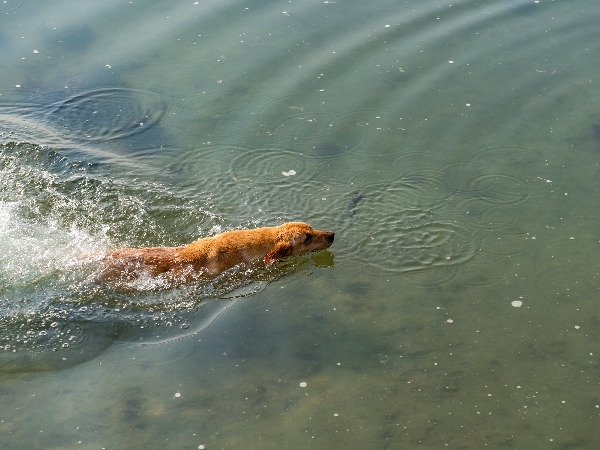
How long does it take for a dog to get sick from blue-green algae?
Symptoms can appear within just a few minutes to hours of exposure.
Can other pets such as cats get blue-green algae poisoning?
Cyanobacteria's toxins can affect all types of animals, including cats, however due to their tendency to avoid swimming, and their choosy attitude towards the water they drink, your cat’s chances of being exposed to blue-green algae are significantly lower than a dogs.
Should I report a sighting of blue-green algae in the UK?
Yes. There are different ways to report any suspected blue-green algae blooms.
The best way to report a suspected cyanobacteria bloom is to download the Bloomin Algae app on both Google Play and the Apple store. This will allow you to add a location, date, bloom size and leave a comment. You can also view images of blue-green algae to compare with what you see. If your suspicions are correct, they will update their interactive map to alert people to the bloom.
The responsibility to then manage algal blooms is with the owners of the water in your local authority. As such, you should contact them directly.
In England the Environment Agency has a 24 hour hotline that you can call on 0800 80 70 60
Natural Resources Wales can be contacted on 0300 065 3000
Northern Ireland Environment Agency can be contacted on 0800 80 70 60 or emailed at emergency-pollution@daera-ni.gov.uk
The Scottish Environment Protection Agency can be contacted online or by telephone at 0800 80 70 60
You can also report a possible sighting in canals and rivers to the Canal and River Trust using their online contact form. Simply choose the option that says ‘Report an issue or a problem with one of our canals or rivers’.
Can humans get blue-green algae poisoning?
Yes, although it is milder than dogs. Coming into contact with cyanobacteria blooms can lead to skin irritation, mild breathing issues, and hay fever-like signs. If ingested, the toxins can create gastrointestinal distress with symptoms like nausea, diarrhoea, fever, and migraine. Additionally, it can have a damaging effect on the liver and the central nervous system but this is less common. Children are more susceptible.
Need more info?
If you’ve any questions about protecting your puppy or dog from blue-green algae, just call or visit your local vet.
Find your nearest vet using our Find a Vet page, or speak to a vet online using Online Vets.
